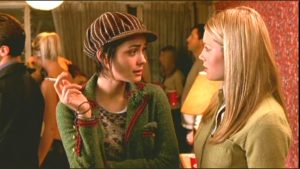Bret Easton Ellis is probably one of the most disturbing authors to come out of the last decade or so. His first book, “Less than Zero,” was glossed over by Hollywood for cinematic treatment, but his 1991 novel-turned-movie “American Psycho” shocked audiences with its gory over attention to detail, and in the devious, sinister performance brought to the table by Christian Bale. Ellis’ style, a mixture of humor, satire, and twisted psychology, had an almost controversial impact on audiences, with critics labeling his works “brilliant,” “notorious,” and even “superficial.”
The 2002 motion picture, “The Rules of Attraction,” based on his 1987 novel of the same name is no different, and offers audiences a bizarre, disturbing, and tragic look at a group of college-aged adolescents.
“The Rules of Attraction” is another in a line of multiple character story-arch epics, but told predominately through the point of view of three main characters: Sean Bateman (James Van Der Beek, “Dawson’s Creek”), Lauren Hynde (Shannyn Sossamon, “40 Days and 40 Nights“), and Paul Denton (Ian Somerhalder, “Life as a House”).
The movie opens at a party at preppy Camden College called “The End of the World,” which only pales in relation to subsequent parties “The Edge of the World,” and the “Dress to Get Screwed Party.” Nomenclature aside, the only apparent goal of these revelries is to drink, use drugs, and have sex. However, what sets “The Rules of Attraction” aside from a hundred other sexed-out college movies lies in its character development, and the portrayal of these parties (and the effect they have on its three protagonists) as the dark, troublesome occurrences they truly are.

The opening scene chronicles Lauren losing her virginity to a ‘townie,’ but then backtracks in time to show how grossly far from her desires this act really was. We then see Sean hitting on a girl from class (Kate Bosworth, “Blue Crush”) and deciding through a list of options – take her to breakfast and leave her with the check, taker her back to his room and screw her, go back to his room and masturbate – before ultimately hooking up with her. And then we have bi-sexual Paul, hitting on a boy he thinks to be gay which ends up getting him beat up, leaving him to smoke cigarettes and drink for the remainder of the party. The effects these actions have on all three aren’t presented as life altering events, but as bleak, colorless glimpses into tortured souls.
Acting by all three sells the movie to us, but none so attention-grabbing as Van Der Beek, who effectively murders Dawson Leery with his portrayal of Sean Bateman. Part-time drug dealer, part-time student, Bateman has run-ins with degenerate classmates and vicious drug dealers but still saves enough time for Saturday class where he meets (and develops infatuations for) Lauren. Somehow Van Der Beek nails the role, acting one part tough-guy, one part vulnerable, and one part “emotional vampire” as he himself puts it. I watched him intently, waiting for him to show just one glimpse of the hopeful and naive Dawson Leery. But it never happened.
Sossamon does a fairly competent job as Lauren, the sole female the movie focuses on for its feminine point of view, but her character isn’t as defined as the male leads, as she more or less bounces from one wrong decision after another. Saving herself for a boy named Victor traveling abroad, she becomes drawn to Sean out of necessity, although it does seem the two have a good deal of chemistry. However, “The Rules of Attraction” is not a love story, but an exercise in self-loathing. Bateman, thinking she is leaving him love notes (she is not), quickly falls for her but with disastrous results. One of the two always in the wrong place at the wrong time, “Rules” makes a point of keeping them apart and making both, but particularly Bateman, suffer for it.
Like most of Ellis’ novels, the film avoids moralizing at all costs, depicting the desperation an depression felt by the characters as objective, thus making the effect all the more chilling. Scenes such as suicides (both attempted and successful), drug deals, fetish parties, drinking, drugs, and sex are purposefully interwoven with the humdrum of classes, boring routine, and methodical inner monologues. The proceedings are set amidst a widely varied soundtrack, featuring songs by ‘Bondie,’ George Michael,’ Starland Vocal Band, ‘tomandandy,’ and ‘The Cure.’ The effect is a perpetually unfulfilled hope – we only understand enough about the characters to feel sorry for them, but never enough to get to feel we know them.
This is a unique film. If you’ve never read a book by Easton Ellis, or have never seen “American Psycho,” the film may surprise you more than if you’re familiar with his works. The movie is a work of satire, but a satire achieved by depicting often-monstrous actions through a flat, emotionless lens – an effect that makes these actions all the more confused and scarring. Supporting performances by Kip Purdue, Thomas Ian Nicholas, Jessica Biel, Clifton Collins Jr., and Fred Savage (“The Wonder Years”) further blur the lines between a drug-induced fog and reality.
“The Rules of Attraction” is a bizarrely philosophical look at a bunch of people making every decision but the right one, and ending up not the better for it. It’s also one of those movies that put you in a haze long after the credits disappear, causing you to ask “what the hell did I just watch?” But honestly it’s a competent movie, and with decisive direction and solid acting from its main cast, offers a unique look at college life not often seen in movies. There’s drinking, there’s drugs, and there’s sex…but there’s a lot more factored in, a lot more often left out of campier movies on the subject, which makes it an honest and introspective film, while managing to be generally entertaining throughout.
– by Mark Ziobro